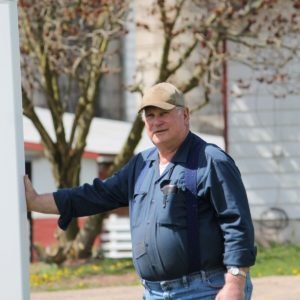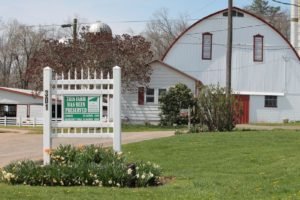AGRICULTURE ORAL HISTORY INTERVIEWS
OSCAR AND WINIFRED (WINNIE) CAMPBELL
Campbell Road
Juniata Township
Interviewed by Jane Hoover April 19, 2016
Oscar (b. 1942) and Winifred(b. 1960) live on his family farm near Markelsville. Oscar has been active on the boards of the Soil Conservation District and the Extension Office most of his life, while also farming his own land and eight farms on which he has rented land. Winnie works in Newport.
JANE: Tell us about how you came to be here on this piece of land.
OSCAR: Actually my granddad bought this tract of land in 1917. Then my dad bought it from him. At that time the only way in and out was across the creek down here. About 1940 they built this house and I was born in it in 1942. When I got to be a teenager, I wanted to milk cows. Why I don’t know. There were no buildings other than the house on the tract, so my dad told me if I wanted to milk cows and have a barn, we would have to go out to the woods and cut the trees. And that’s how we got started on building a barn. Everything you see around here, we’ve built.
About a third of the farm up here was in pine trees. We cleared that off, but the ground was so poor it wouldn’t grow anything. I contacted the Soil Conservation District, Extension Office and the Soil Conservation Service (SCS), now known as the Natural Resources Conservation Service (NRCS). With their help I got these fields to start producing. That was my introduction to soil conservation. My bottom land here was nothing but brush. We cleaned that up and put field tile in so I could farm it. I always felt I owed them something because I got so much help from those three organizations so I could farm and make a decent living out of it. When the opportunity came to participate, to become active, I said yes. I’m trying to pay back the debt.
JANE: Can you give us a sense of the timeline for all this work and community service?

OSCAR: I probably started serving on these committees in the mid 60’s. It would have been a few years after I graduated from high school. At that time I was trying to build up the soil on the bottom land, just as I was on the hill. We were plowing during that period. Cover crops are a big thing today, but we were doing cover crops even back then to build up the soil. When the Agnes Flood came in 1972, we were plowing. I had corn planted in the meadow and the corn was probably close to knee high. It looked beautiful. Then it rained and we had this flood. Because I had plowed the ground, the soil was loose, letting the flood wash away maybe six inches of top soil. These three organizations helped me get the soil built back up.
1972 was before all the regulations came on streams. We wanted to do something to keep more floods out of the field. The water had deposited an island of silt in the middle of the creek. The Soil Conservation Service actually let me use the silt and rocks from the stream and soil from behind the barn to build a dike down here. They wouldn’t allow that today. Shortly after 1972, water quality restrictions would have prohibited digging in the stream or building a dike.
They built it six inches higher than the Agnes flood had been. Believe it or not, the creek has flooded over that dike twice, the last time in late May 2014. That time, the water was even faster than in 1972 because all the rain came within 12 hours instead of over several days. I had corn in it again, maybe three or four inches high. Believe it or not, I did not have to replant that corn because I was no-till and the soil was still there.
JANE: Just to clarify, when you plow and cultivate, you loosen up the soil making it easier to wash away?
OSCAR: Yes, yes. With the no-till we put cover crops in over the wintertime. We spray the cover crop in the spring to burn it down. It actually helps to build soil and keep it healthy. What you see above the ground, there has at least that much in roots below the ground. It builds up organic matter and saves the ground from washing. I do it mainly on soybean ground and on wheat stubble, which are going to lay. I use Triticale because it’s cheaper than the oats/radish/annual rye-grass mix. That was $30 per acre. The Triticale is only $17 per acre.
JANE: So you don’t raise the Triticale as a crop?
OSCAR: Not down here in the bottom land. On the hill where I have Triticale under- planted with timothy. I want a timothy crop, so we will mow the Triticale off in May. It makes great cow feed. Also, I can’t grow beans or alfalfa or corn up there because the deer eat it all. Timothy is the only thing I can grow that the deer won’t eat.
JANE: What other conservation measures do you use?
OSCAR: There’s an eight foot wide waterway between the fields in the bottom. I put that in with help from the NRCS through the Environmental Quality Incentives Program (EQIP). The idea of that was to keep the water from around the buildings from running into the fields and laying there. It collects the runoff and diverts it to another waterway between the two farms and then down into the creek. So I have to be careful I don’t pollute around the buildings with potential runoff into the creek. I am going to participate in a water quality program where they take water samples periodically from the waterways to see if I am polluting. If I am, I will have to change my ways.
At one time, I farmed eight different farms. For every one I got help from NRCS. I strip cropped every farm. We laid them out to the contour of the land so we would farm with the lay of the land. And we put a lot of grass waterways in. With the kind of rains we are having now, any soybean strips I don’t get cover crops on get sheet erosion, the little ripples down the hill. So this fall I have to do a better effort to get cover crops on everything.
JANE: When you spray your burndown, how do you keep the spray from killing the grass in the waterways?
OSCAR: I shut my sprayer off when I cross a waterway and not spray when it’s windy. Also I spray up and down around the waterway first, so it’s easier when I do the horizontal runs to shut the sprayer off before I cross the waterway. I like the grass waterways. It takes the silt out of the water instead of letting it run down the hill. I’ve seen silt in my waterways. Some of them have filled up so much we’ve had to clean them out with a dozer and push the silt back in the field. That’s your best soil. You don’t want to lose it.
I use a lot of Roundup, which is supposed to be neutralized when it hits the soil. Going to meetings last winter, I learned that you can’t use Atrazine within 200 feet of a stream, so I started using Symazine which doesn’t have the water quality issues. But you’ve got to follow the label and not go over label. That’s where you get in trouble, when you apply more than the label states, because that will stay in the ground.
JANE: Do you have children who will take over the farm?
OSCAR: I have a daughter who is married to a farmer up in Juniata County. She has two daughters and I am hoping one of them will take over the farm. After all, next year it will have been in the family 100 years. I plan to apply for Century Farm status for it. Last year the neighbor took a picture of all of us in front of our Farmland Preservation sign. You can see in that picture, the barn is in the background and the sign is there. That’s been my whole life. Everything I’ve ever done, I’ve put back into the farm.

JANE: This is really a passion for you. The give-back portion is huge.
OSCAR: That’s why I do it. I think sometimes I’m nuts for going out to so many meetings. But I feel really motivated to give back to the organizations that have helped me so much over the years. I’ve been on the board of the Conservation District 24 years, and I think I’ve been chairman 22 of those years. No other boards right now. It was just getting to be too much. I was on the Extension Board before I was married, back in the days of Roy Snyder (senior extension agent from 1948 to 1980.) But you can only be on the board for five years and then you have to go off. I’d be off a year and then I would go back on. When I got married I’d go off and Winnie would come on, serve her five years, go off and I would return, and so on. Two years ago, we felt we had to give it up. But also I think younger people need the opportunity to become involved in these organizations if you want to keep them going.
We always were an organization that tried to help people, whether it was farmers or people with their backyards. We were a service organization. The sad part of it now is that the Department of Environmental Protection (DEP) wants to give us the enforcement piece and we don’t want it because we don’t feel that is what our purpose is. We’re going to have to make a decision in the next month or two. I like helping people. I don’t like going out and saying, “If you don’t do it right, we’re going to fine you.” We’re still going to help people, but will they come to us for help if they are afraid we might see something we don’t like and penalize them.
For example, the Environmental Protection Agency (EPA) will withhold $3 M of the Chesapeake Bay money from DEP, if DEP doesn’t make the districts enforce the setbacks. (The Federal government has set aside money to clean up the Chesapeake Bay. EPA is the enforcement agency and EPA believes additional protection is necessary to reduce runoff from farms in the watershed. Requiring farmers to leave a buffer strip or setback between the farmed land and a stream is one enforcement tool.) It’s Bay money that operates the four no-till drills that we make available to farmers to help them convert to no-till. The farmers can rent the drills from us. So we are looking for other sources of funding to operate that drill program. It’s important to the county. We’re planting 4000 acres a year with those drills. Those drills are part of our effort to get farmers to convert to no-till and reduce sediment and chemical runoff into the Bay. But will farmers ask us to bring the drills out if we might see insufficient setbacks and force the farmer to take land out of production to meet the setback requirements?
Knowing what I know now, I’m going to widen my buffer strips where they are too narrow. But who’s going to pay for it if farmers are required to take land out of production to create wider buffer strips between their cropland and the stream?
